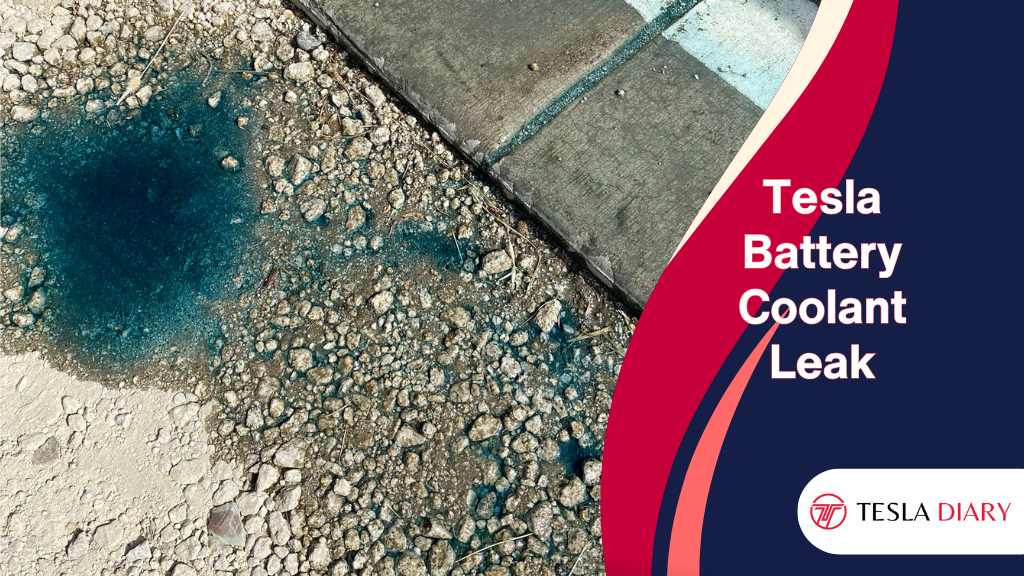While electric cars have many advantages, they are not exempt from maintenance issues, and one common problem that Tesla owners may encounter is a coolant leak.
In this article, we will discuss what to do if you discover a battery coolant leak in your Tesla.
If you find blue fluid leaking from your Tesla, you should take your car to the nearest Tesla service center for a fix. It’s probably a leak in your battery cooling system and you will need to replace the entire battery pack. Symptoms of a Battery coolant leak and distinguishing features of a battery coolant leak from other fluid leaks are elaborated below.
Tesla Battery Coolant System in Brief
Tesla uses a liquid cooling system to regulate the temperature of the battery pack and other components of the electric drivetrain.
The coolant, typically a mixture of water and glycol, circulates through a network of pipes, hoses, and a heat exchanger, helping to dissipate excess heat generated during battery charging and discharging.

The coolant also plays a crucial role in ensuring that the battery operates within its optimal temperature range, which is vital for performance and longevity.
While the coolant leak might not seem like a big deal, it is! Tesla does not repair or refill leaked coolants on its batteries. The only way out is to replace the battery if your Tesla leaks battery coolant. That’s why you need to determine what actually is leaking.
Signs of a Battery Coolant Leak
Detecting a coolant leak in your Tesla is the first step in addressing the issue. Here are some common signs to look for:
1. Puddles or Drips
If you notice puddles or drips of a bright-colored liquid under your Tesla when parked, it is a clear indication of a coolant leak.
The coolant used in Tesla batteries is typically blue, making it relatively easy to identify.
2. Warning Message
Your Tesla’s onboard computer system is designed to monitor various vehicle parameters, including coolant levels and temperatures.
If there is a significant drop in coolant levels or a spike in temperature, your car’s dashboard should display warning messages, for example, Coolant low, performance may be limited. Ignoring these warnings is not advisable.
3. Overheating
A sudden increase in the operating temperature of your Tesla can also be a sign of a coolant leak.
Overheating can lead to reduced performance and, if left unaddressed, could cause serious damage to your electric vehicle.
4. Unusual Smells
Coolant leaks can sometimes produce a distinct odor, often described as sweet or syrupy. If you notice such a smell inside or around your Tesla, it’s essential to investigate further.
The sweet odor is created by toxic cooling liquid used in the battery such as ethylene glycol.
5. Consistency of the Fluid
Another way to distinguish coolant from other fluids is by its consistency. Coolant is typically thinner and less viscous than engine oil, which is usually darker and thicker.
Transmission fluid and brake fluid also have different consistencies and colors.
- Coolant Consistency: Thin, watery, and slippery to touch.
Steps to Take When You Discover a Coolant Leak
If you suspect or confirm a coolant leak in your Tesla, it’s crucial to act promptly to prevent further damage and ensure your safety. Here are the steps to follow:
1. Safety First
Safety should always be your top priority. If you notice a coolant leak while driving, pull over to a safe location, turn off your Tesla, and engage the hazard lights.
Make sure you are in a secure area away from traffic.
2. Assess the Leak
Once your safety is ensured, take a closer look at the coolant leak. Try to identify the source of the leak and the severity of the issue.
Is the leak minor, or is it gushing out? The location and extent of the leak will help determine your next steps.
3. Contact Tesla Service
As soon as you safely can, contact Tesla’s customer support or roadside assistance. Tesla’s customer service will guide you on what to do next.
They may recommend having your Tesla towed to the nearest service center for inspection and repair.
Also, Contact your Insurance Provider as it is likely that you may need to have your battery replaced which is a hefty price unless you are covered by warranty or insurance.
4. Avoid DIY Repairs
While it might be tempting to try and fix the coolant leak yourself, it is not advisable unless you are a trained technician with experience working on electric vehicles.
Tesla’s cooling system is complex, and attempting DIY repairs could void your warranty or cause more significant damage.
Also, Tesla says that coolant leak repair is not a viable option for the safety of your vehicle and its passengers. So, it is better to avoid DIY here.
5. Monitor the Situation
While waiting for assistance or towing, monitor your Tesla’s temperature gauge and warning messages.
If your vehicle starts to overheat or displays critical warnings, it’s crucial to turn it off and wait for professional assistance.
6. Document the Leak
Take photos or videos of the coolant leak, if possible. This documentation can be valuable when discussing the issue with Tesla’s service team and for warranty claims.
7. Consider Roadside Assistance
If your Tesla is still within coverage (within 4 years or 50,000 miles on the odometer), you are eligible for free roadside assistance.
Tesla’s service team can arrange for a tow truck to transport your vehicle to the nearest service center for evaluation and repair.
Conclusion
Discovering a battery coolant leak in your Tesla can be concerning, but taking the right steps promptly can help minimize damage and ensure your safety.
Remember to prioritize safety, contact Tesla’s customer service for assistance, and avoid attempting DIY repairs.
By following these guidelines and staying on top of your vehicle’s maintenance, you can enjoy the benefits of electric vehicle ownership with confidence and peace of mind.

